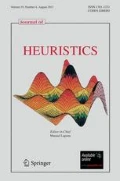Abstract
For hard optimization problems, it is difficult to design heuristic algorithms which exhibit uniformly superior performance for all problem instances. As a result it becomes necessary to tailor the algorithms based on the problem instance. In this paper, we introduce the use of a cooperative problem solving team of heuristics that evolves algorithms for a given problem instance. The efficacy of this method is examined by solving six difficult instances of a bicriteria sparse multiple knapsack problem. Results indicate that such tailored algorithms uniformly improve solutions as compared to using predesigned heuristic algorithms.
Similar content being viewed by others
References
Battiti, R. and G. Tecchiolli. (1994). “The Reactive Tabu Search.” ORSA Journal on Computing 6(2), 120–140.
Coffman, E., M. Garey, and D. Johnson. (1984). “Approximation Algorithms for Binpacking: An Updated Survey.” In G. Ausiello, M. Lucertini, and P. Serafini (eds.), Algorithm Design for Computer System Design. Wien: Springer-Verlag, pp. 49–106.
Coffman, E., M. Garey, and D. Johnson. (1997). “Approximation Algorithms for Binpacking: A Survey.” In D. Hochbaum (ed.), Approximation Algorithms for NP-hard Problems. Boston: PWS Publishing Company, pp. 46–93.
CPLEX (1994). “Using the CPLEX Linear Optimizer.” CPLEX Optimization Inc.
Dawande, M., J. Kalagnanam, P. Keskinocek, R. Ravi, and F.S. Salman. (1998). “Approximation Algorithms for the Multiple Knapsack Problem with Assignment Restrictions.” Technical Report, IBM T. J. Watson Research Center, P.O. Box 18, Yorktown Heights, New York 10598, USA.
Erman, L.D., F.A. Hayes-Roth, V.R. Lesser, and D.R. Reddy. (1980). “The Hearsay-II Speech-Understanding System: Integrating Knowledge to Resolve Uncertainty.” Computing Surveys 12, 213–253.
Ferreira, C., A. Martin, and R. Weismantel. (1996). “Solving Multiple Knapsack Problems by Cutting Planes.” SIAM J. Optimization 6(3), 858–877.
Friesen, D. and M. Langston. (1986). “Variable Sized Bin Packing.” SIAM J. Computing 15, 222–230.
Garey, M. and D. Johnson. (1979). Computers and Intractibility: A Guide to the Theory of NP-Completeness. San Francisco: W.H. Freeman and Co.
Glover, F. (1989). “Tabu Search Part I.” Operations Research Society of America (ORSA) Journal on Computing 1(3), 109–206.
Glover, F. (1990). “Tabu Search Part II.” Operations Research Society of America (ORSA) Journal on Computing 2(1), 4–32.
Gomes, C.P. and B. Selman. (1997). “Algorithm Portfolio Design: Theory vs. Practice.” In Proc. Uncertainty in Artificial Intelligence.
Holland, J.H. (1975). Adaptation in Natural and Artificial Systems: An Introductory Analysis with Applications to Biology, Control, and Artificial Intelligence. Ann Arbor, MI: University of Michigan Press.
Huberman, B.A., R.M. Lukose, and T. Hogg. (1997). “An Economics Approach to Hard Computational Problems.” Science 265, 51–54.
Hung, M. and J. Fisk. (1978). “An Algorithm for 0-1 Multiple Knapsack Problems.” Naval Res. Logist. Quarterly 24, 571–579.
Kalagnanam, J., M. Dawande, M. Trumbo, and H.S. Lee. (1998). “The Surplus Inventory Matching Problem in the Process Industry.” Technical Report RC21071, IBM T. J. Watson Research Center.
Karp, R. (1972). “Reducibility among Combinatorial Problems.” In R. Miller and J. Thatcher (eds.), Complexity of Computer Computations. New York: Plenum Press, pp. 85–103.
Keskinocak, P., F. Wu, R. Goodwin, S. Murthy, R. Akkiraju, S. Kumaran, and A. Derebail. (1998). “Scheduling Solutions for the Paper Industry.” Technical Report, IBM T. J.Watson Research Center, P.O. Box 18, Yorktown Heights, New York 10598.
Lee, H., S. Murthy, S. Haider, and D. Morse. (1996). “Primary Production Scheduling at Steel-Making Industries.” IBM Journal of Research and Development.
Martello, S. and P. Toth. (1980). “Solution of the Zero-One Multiple Knapsack Problem.” Euro. J. Oper. Res. 4, 322–329.
Martello, S. and P. Toth. (1981a). “A Bound and Bound Algorithm for the Zero-One Multiple Knapsack Problem.” Discrete Applied Math. 3, 275–288.
Martello, S. and P. Toth. (1981b). “Heuristic Algorithms for the Multiple Knapsack Problem.” Computing 27, 93–112.
Martello, S. and P. Toth. (1989). Knapsack Problems. New York: John Wiley and Sons.
Martello, S. and P. Toth. (1990). Lower Bounds and Reduction Procedures for the Bin Packing Problem. Discrete Applied Math. 28, 59–70.
Mockus, J. (1989). Bayesian Approach to Global Optimization. Dordrecht: Kluwer Academic Publishers.
Murthy, S. (1992). “Synergy in Cooperating Agents: Designing Manipulators from Task Specifications.” Ph.D. Thesis, Dept. of Electrical and Computer Engineering, Carnegie Mellon University.
Murthy, S., R. Akkiraju, J. Rachlin, and F. Wu. (1997). “Agent-Based Cooperative Scheduling.” In E.C. Charniak (ed.), Constraints and Agents, AAAI-97 Workshop, pp. 112–117.
Näher, S. and C. Uhrig. (1995). Leda User Manual. Saarbrücken, Germany: Max-Planck-Institute für Informatik.
Rodosek, R., M.G. Wallace, and M.T. Hajian. (1999). “ANewApproach to Integrating Mixed Integer Programming with Constraint Logic Programming.” In Annals of Operational Research: Recent Advances in Combinatorial Optimization: Theory and Applications.
Smith, S.F., P.S. Ow, J. Potwin, N. Muscettola, and D.C. Matthys. (1990). “An Integrated Framework for Generating and Revising Factory Schedules.” Journal of the Operational Research Society 41, 539–552.
Talukdar, S. and P. de Souza. (1993). “Asynchronous Organizations for Multi-Algorithm Problems.” In E. Deaton, H. George, K.M. Bergel, and G. Hedrick (eds.), Proceeding of 8th SIGAPP Symposium on Applied Computing, pp. 286–293.
Talukdar, S., P. de Souza, and S. Murthy. (1993). “Organizations for Computer-Based Agents.” Engineering Intelligent Systems 1(2).
Author information
Authors and Affiliations
Rights and permissions
About this article
Cite this article
Salman, F.S., Kalagnanam, J.R., Murthy, S. et al. Cooperative Strategies for Solving the Bicriteria Sparse Multiple Knapsack Problem. Journal of Heuristics 8, 215–239 (2002). https://doi.org/10.1023/A:1017964608086
Issue Date:
DOI: https://doi.org/10.1023/A:1017964608086




